
Cleveland, officially the City of Cleveland, is a major city in the U.S. state of Ohio, and the county seat of Cuyahoga County. It is located along the southern shore of Lake Erie, across the U.S. maritime border with Canada and approximately 60 miles west of the Ohio-Pennsylvania state border.

The Cleveland Museum of Art (CMA) is an art museum in Cleveland, Ohio, located in the Wade Park District, in the University Circle neighborhood on the city's east side. Internationally renowned for its substantial holdings of Asian and Egyptian art, the museum houses a diverse permanent collection of more than 61,000 works of art from around the world. The museum provides general admission free to the public. With a $755 million endowment, it is the fourth-wealthiest art museum in the United States. With about 770,000 visitors annually (2018), it is one of the most visited art museums in the world.
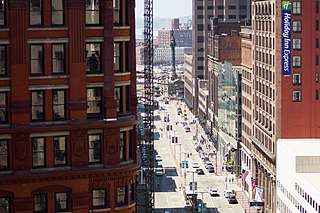
Euclid Avenue is a major street in Cleveland, Ohio. It runs northeasterly from Public Square in Downtown Cleveland, through the cities of East Cleveland, Euclid and Wickliffe, to the suburb of Willoughby as a part of U.S. Route 20 and U.S. Route 6. The street passes Playhouse Square, University Circle, Cleveland State University, the Cleveland Clinic, Severance Hall, Case Western Reserve University’s Maltz Performing Arts Center, Case Western Reserve University and University Hospitals Case Medical Center. The HealthLine bus rapid transit line runs in designated bus lanes in the median of Euclid Avenue from Public Square to Louis Stokes Station at Windermere in East Cleveland.

Jeptha Homer Wade was an American industrialist, philanthropist, and one of the founding members of Western Union Telegraph. Wade was born in Romulus, New York, the youngest of nine children of Jeptha and Sarah (Allen) Wade. He made the first Daguerreotypes west of New York, was a portrait painter, and moved to Adrian, Michigan in 1840 before developing an interest in the telegraph.
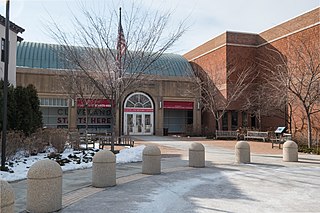
The Western Reserve Historical Society (WRHS) is a historical society in Cleveland, Ohio. The society operates the Cleveland History Center, a collection of museums in University Circle.

University Circle is a district in the neighborhood of University on the east side of Cleveland, Ohio. One of America's densest concentrations of cultural attractions and performing arts venues, it includes such world-class institutions as the Cleveland Museum of Art; Severance Hall, home to the Cleveland Orchestra; the Cleveland Institute of Art; Case Western Reserve University; the Cleveland Institute of Music; the Museum of Contemporary Art Cleveland; the Cleveland Botanical Garden; historic Lake View Cemetery; the Cleveland Museum of Natural History; and University Hospitals/Case Medical Center. The area is also known as "The Circle" to locals. Encompassing approximately 550 acres (220 ha) the University neighborhood is bordered to the north by the Glenville neighborhood, to the south by the Buckeye-Shaker neighborhood, to the west and southwest by the neighborhoods of Hough and Fairfax and to the east by the cities of East Cleveland and Cleveland Heights. University Circle is member of the Global Cultural Districts Network.
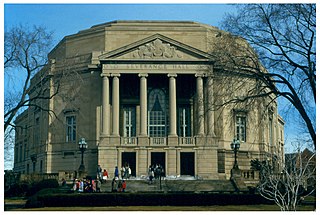
Severance Hall is a concert hall located in the University Circle section of Cleveland, Ohio. Opened in 1931, Severance Hall was named after patrons John L. Severance and his wife, Elisabeth Huntingdon DeWitt Severance, and serves as the home of The Cleveland Orchestra. It is currently listed on the National Register of Historic Places as part of Cleveland’s Wade Park District.

Downtown Cleveland is the central business district of Cleveland, Ohio. It is the economic and symbolic center of the Cleveland-Akron-Canton, OH Combined Statistical Area.

The DuSable Museum of African American History in Chicago is dedicated to the study and conservation of African-American history, culture, and art. It was founded in 1961 by Margaret Taylor-Burroughs, her husband Charles Burroughs, Gerard Lew, Eugene Feldman, Bernard Goss, Marian M. Hadley, and others. They established the museum to celebrate black culture, at the time overlooked by most museums and academic establishments. The museum has an affiliation with the Smithsonian Institution.
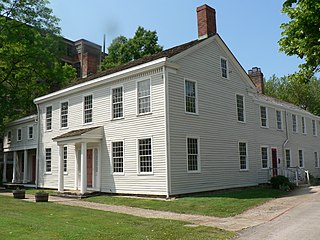
The Dunham Tavern, located at 6709 Euclid Avenue, is the oldest building in Cleveland, Ohio. Rufus and Jane Pratt Dunham built their first home on the site in 1824, and the existing taproom was built in 1842. It is believed to be the first building constructed on Euclid Avenue east of East 55th Street and the first frame house on the street. It later became a stagecoach stop and tavern.
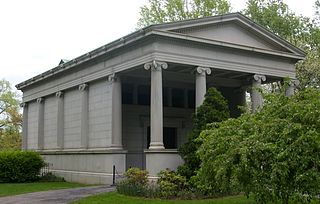
Wade Memorial Chapel is a Neoclassical chapel and receiving vault located at Lake View Cemetery in Cleveland, Ohio, in the United States. It was donated to the cemetery by Jeptha Wade II in memory of his grandfather, cemetery and Western Union co-founder Jeptha Wade. The overall design was by the newly-founded Cleveland area architectural firm of Hubbell & Benes, and was their first commission. The interior's overall design is by Louis Comfort Tiffany based on a preexisting 1893 design. The interior features two mosaics on the right and left hand walls, and a large stained glass window.

This is a list of the National Register of Historic Places listings in Cleveland, Ohio.

Rockefeller Park is a city park named in honor of oil magnate John D. Rockefeller Sr., located in Cleveland, Ohio. Part of the Cleveland Public Parks District, Rockefeller Park is immediately adjacent Wade Park to the southeast, and across Euclid Ave on its northwest border. Besides the distinction of being the largest park located completely within city limits, Rockefeller Park is a link in a chain of parkland that connects the heights region of the eastern suburbs to the city's lakefront. Following the path of Martin Luther King Jr. Drive and spanning a large section of Cleveland's East Sides, the park runs in a northwesterly path between suburban Shaker Heights, bisecting the University Circle neighborhood and terminating at Gordon Park on the city's lakefront, opened to the public in 1897. The park was dramatically expanded during the 1930s with labor provided by the Works Progress Administration. Landmarks found in Rockefeller Park include two separate entries on the National Register of Historic Places: one for its architecturally historic bridges, and one for its Cultural Gardens.

Wade Park is a park in the University Circle neighborhood of Cleveland, Ohio. Wade Park today largely serves as the campus for the Cleveland Museum of Art, the Cleveland Botanical Garden, and the Cleveland Museum of Natural History, as well as Wade Lagoon, which faces the Museum of Art from the south end of the park. Though not technically a historical landmark itself, the park falls within the eponymous Wade Park historical district and serves as a backdrop for most of its registered buildings.

Hubbell & Benes was a prominent Cleveland, Ohio architectural firm formed by Benjamin Hubbell (1857–1935) and W. Dominick Benes (1867–1953) in 1897 after the pair departed from Coburn, Barnum, Benes & Hubbell. Their work included commercial and residential buildings as well as telephone exchange buildings, the West Side Market and Cleveland Museum of Art. Before teaming up, they worked for Coburn and Barnum. Benes was Jeptha Wade’s personal architect and designed numerous public buildings, commercial buildings, and residences for him including the Wade Memorial Chapel.
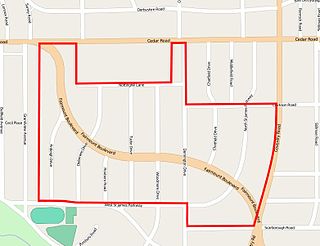
The Euclid Golf Allotment, also known as the Euclid Golf Historic District, is a historic district located in Cleveland Heights, Ohio, in the United States. Roughly bounded by Cedar Road, Coventry Road, West St. James Parkway, and Ardleigh Drive, the 142-acre (0.57 km2) site contains primarily residential homes built between 1913 and 1929. The historic district is built on land formerly owned by John D. Rockefeller and at one time leased to the Euclid Golf Club for its back nine holes, and it takes its name from this historic factoid. The Euclid Golf Allotment is a largely undisturbed example of an early 20th century planned community containing American Craftsman, Colonial Revival, French Renaissance Revival, Italian Renaissance Revival, Prairie School, Shingle Style, and Tudor Revival architecture.

The Ansel Road Apartment Buildings Historic District is a historic residential district in the Hough neighborhood of Cleveland, Ohio, in the United States. The district consists of eight contributing and one non-contributing multi-family residential buildings built between 1900 and 1949. The area was designated a National Historic District and listed on the National Register of Historic Places on July 2, 2008.
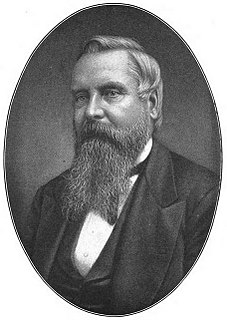
Henry Chisholm was a Scottish American businessman and steel industry executive during the Gilded Age in the United States. A resident of Cleveland, Ohio, he purchased a small, struggling iron foundry which became the Cleveland Rolling Mill, one of the largest steel firms in the nation. He is known as the "father of the Cleveland steel trade".

Hinman B. Hurlbut was an American industrialist and philanthropist. A native of New York, Hurlbut relocated to Cleveland, Ohio, in 1837 and started a career privately practicing law in Massillon, Ohio after being admitted to the bar in 1839. After a lucrative career as a lawyer, he found success as a business leader in Cleveland and came to own four national banks by 1863.

The Mather Mansion as it is officially known was completed in 1910 by the famous New York-trained preeminent Cleveland architect Charles F. Schweinfurth who built the 45-room Tudor Revival style home for the illustrious Cleveland shipping and ore mining magnate Samuel Livingston Mather. The home sits on the prominent Cleveland thoroughfare of Euclid Avenue near the I-90 Bridge located by East 30th Street.























